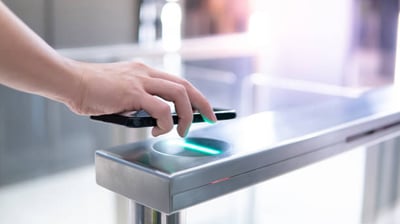June 15, 2022
 by Christine Joy Santiago / June 15, 2022
by Christine Joy Santiago / June 15, 2022

QR codes are now a familiar sight.
Everywhere you go, you see square, black-and-white matrix barcodes printed on building entrances, printed materials, and product packaging. You even see them in commercials, TV shows, and on some notable occasions lighting up the sky in a spectacular drone show.
You may know that scanning a QR code with your mobile device takes you to a website, file, or menu. But what are QR codes really? How do they work? How are they made? How does your device recognize them?
Let's break this down for you.
The "QR" in the QR code stands for "Quick Response". It’s a two-dimensional matrix barcode that can be read and scanned with compatible devices such as a smartphone camera or an app.
With an online QR code generator, you can create QR codes readable in both vertical and horizontal dimensions. QR codes can store various data and information, including a link to an online store, an influencer's social media sites, and files such as photos, videos, music, official documents, and more.
QR codes hold more data than a barcode. A barcode consists of a series of characters, numbers, and symbols, while a QR code can store up to 406 bytes of information. QR codes are a practical and highly efficient tool, bridging the gap between the physical and digital worlds.
Don’t waste time on clunky, outdated tools. Check out our top picks for the best QR code generator software, and start creating smarter QR codes today.
Each black and white square in a QR code represents “one bit,” encoding different characters into the text. QR codes use three big squares for alignment so you can scan them in any direction. The other little squares help a QR code scanner read the code.
QR codes have a major advantage over regular barcodes as they’re two-dimensional and only require a QR code scanner (most of which are free) that people can install on their smartphones.
A barcode contains machine-readable information, is one-dimensional, and contains information horizontally. On the other hand, QR codes can be decoded in different directions, which means they can encode over a hundred times more data.
A Denso Wave engineer named Masahiro Hara invented QR codes in 1994. Because every car component has a unique size, function, and fit, Masahiro created QR codes to eliminate a mechanic's manual labor and prevent errors.
Hara and his team were tasked with creating a QR code that people could use to track a car and its parts during production. They didn't expect people to use QR codes outside the automotive business when they designed it.
“At the time, I felt that I had developed something great and predicted that it would be widely used in the industry in the future. But it was widely used by general users, which I did not expect. It was used as a payment method. It was completely unexpected.“
Furthermore, QR codes were meant to replace the UPC barcodes. QR codes replaced UPC barcodes as they’re much better to use. A QR code can display the data even when scanned in different dimensions. It also stores more information than UPC barcodes.
For a deeper dive into adoption trends, explore the latest QR code statistics covering the latest data and insights.
There are two types of QR codes: static and dynamic. Let's look at each type.
Generating a static QR code is free, and the number of scans provided is unlimited. However, static QR codes are only suitable for one-time use as the user cannot edit the embedded data.
After generating the static QR code, users cannot change the information contained within the code. They can’t also track the number of scans and the scanner's device and location.
A dynamic QR code allows users to track, edit, and update embedded data. This saves a lot of time, effort, and money.
With a dynamic QR, users can change the data or information on it even if the code has already been posted. You can also track QR performance. Dynamic QRs give you access to real-time scan monitoring to track data such as the number of scans, scan locations, scan times, and devices used.
A dynamic QR can be password protected, scan notifications via email, and integrate with analytics tools and other software.
QR codes are popular because you don't need the technical know-how to scan them with your mobile device. It's important to know that Android and iOS perform QR code scanning differently.
QR codes typically redirect users to a website or page containing information about a specific product. A QR code scanner helps reach a landing page displaying user information.
Most Android phones have a QR code scanner. Android versions 8 and above can scan a QR code through the phone camera without third-party apps. However, older versions lack these features.
Follow these steps to see if your smartphone can scan a QR code:
If this doesn't work, your Android phone may not have a QR scanning function. In this case, you need to install a separate QR code scanner application.
The QR code scanning feature is one of the many improvements implemented in iOS 11 and later.
If you're having trouble scanning QR codes, you can enable QR code scanning in the “Settings” app.
Generating a static or dynamic QR code is easy. Just follow these five simple steps.
QR codes come in the same shape but different functions and sizes. You can improve user experience by using the following QR code types.
This QR code contains a specific website’s address. Scanning it automatically redirects you to the website – no more manually entering the web address.
You can generate a vCard QR code and attach it to your business cards. vCard QR helps download your contact information by instantly showing it on the device.
This QR code lets users generate QRs for various file formats, including PDF, JPEG, PNG, MP4, Excel, and Word. These documents are stored on a computer's hard drive or online. And since file QR is dynamic, users can view and edit the data stored in it.
A social media QR code can save all your social media profiles. It’s a powerful solution for users to find your business on social media easily. When they scan the code, all embedded social media pages automatically appear on their smartphones on a single screen.
A menu QR code is one of the most effective solutions for restaurant owners. It allows customers to access the restaurant menu via mobile devices. The menu appears on the customer’s phone after scanning the QR code. This helps business owners reach more customers as QR code menu scanning is easy and promotes contactless payments and more efficient customer service.
With an H5 QR code solution, you can design your landing page without buying a domain name for web hosting. This no-code solution best suits small businesses looking to grow their customers through QR code marketing.
A multi-URL QR code is one of the best features of a dynamic QR. It offers a more personalized user experience as users are guided and redirected based on their language, number of scans, time, and location.
This QR code is meant for businesses that want to create global campaigns to offer different products, goods, services, or even websites to people worldwide.
It’s an inexpensive international marketing method that eliminates the need to deal with regional language issues. One scan easily directs potential customers to a page they can fully identify with, increasing their chances of conversion or purchase.
An App Store QR code directs scanners to a landing page where they can automatically download an application from the App Store or Google Play.
These QRs simplify Wi-Fi connectivity for guests. They improve the guest experience in restaurants, bars, or cafes by providing password-free internet access. Customers don't have to keep asking you for your Wi-Fi credentials. Just post the Wi-Fi QR code where your guests or customers can easily see or get it for an instant scan.
You can generate a QR code from any MP3 file, an audio file, and podcasts. After scanning, the scanner redirects users to your audio file's link.
Each of your social media profiles can have a unique QR code. Users can instantly follow, like, or subscribe to your page or channel when they scan it.
Use a QR code in your email marketing to offer more information about your product or service. This gives you a clearer and more competitive advantage. You go the extra mile by quickly providing customers with the necessary information.
The QR code will also pique the recipient's interest when they read your email. Add a compelling call-to-action (CTA ) to encourage your readers to scan the code.
A text QR code is static and free. QR code software features vary when generating a text-based QR code. Using these solutions, you can convert words, numbers, characters, and even emojis. You also don’t need an internet connection to scan a text QR code.
Marketers are getting even more creative when finding the best ways to get their customers to scan their QR codes. The possibilities are endless. Depending on your business, you can always find different ways to grab your customers' attention and get them to scan.
Below are some of the best ways to use QR codes today.
Social media makes it easy to share personal information, documents, movies, and images globally. A social media QR code allows you to store all your social media channels on one landing page.
You can increase your follower count by linking all your social media profiles with a social media QR code. This gives potential customers easy access to where and how to reach you. Using social QRs also helps promote your page and gain more followers.
When you place a QR code on your product packaging, it does more than just redirect. You can use it to improve a customer's overall satisfaction and experience.
Since QR codes are readable with smartphones, your customers can easily save your company's information. It can be a gateway to simply redirect them to a landing page that displays your company information. A QR code can help you and your business become more adaptable and reach more customers.
As the world changes and becomes more technologically advanced, QR code menus have started to replace paper menus in restaurants, bars, cafes, and salons. For example, if you run a restaurant and want to implement contactless transactions, you can display QR codes so customers can order and pay with one scan.
Customers now prefer reading a virtual manual instead of a paper manual. Placing a QR code on your technical articles gives you the opportunity to give your customers both a physical copy of a manual and a PDF copy. This way, they can easily save the virtual copy to their phone after scanning.
Adding a QR code to your print ad can increase your marketing success by providing your audience with more information and interaction. Your audience can access the embedded QR code information using a smartphone. Customers who scan your QR code are taken to a landing page with more information about your ad.
Using a QR code can also redirect scanners to a landing page where they can download an app immediately.
Business cards often identify an individual and their professional association or company. QR codes on business cards are a new and effective trend in business and marketing.
A business card is often given out during networking, corporate events, or meetings to encourage follow-up. When someone scans the QR code, it automatically redirects them to a landing page that displays a company's basic information, such as a website, social media, and contact information.
You can save time scanning a Wi-Fi QR code on your smartphone and joining a network directly. Users no longer need to type long passwords, reducing the chance of typos.
Now that the most common uses of QR codes are identified, it’s essential to determine whether a QR code generator is credible based on its qualities.
The reliability of a QR code generator isn’t limited to whether it can generate good quality QR codes. To verify a software’s reliability, you also need to see if the site has the most up-to-date and relevant security features, as well as recommendations from well-known global companies. When it comes to data security, there should be no shortcuts. Your business and customers rely on it.
Gaining the trust of prominent brands increases a company's influence over its customers. Legitimate QR code generators are recognized and valued by major companies. It’s also important to look for an ISO 27001-certified QR code generator.
Your information will be classified as highly sensitive or private to ensure security. Always look for software that can guarantee the safety of your sensitive online data.
Since marketing campaigns work best with dynamic QR codes, QR code software should have the best data analysis tools. Dynamic QRs allow you to track your campaign.
Make sure your code generator has features to track the frequency, location, and demographics of people who scanned your campaign. This will give you enough information for future research, such as a feasibility study on the regions or areas of interest.
Software compatibility requires a variety of print formats. The same goes for printing QR codes, as users have different file format preferences. Good QR code generators output JPEG, SVG, EPS, PDF, PNG, etc. Users can choose their QR code format with these options. Multinational corporations see this feature as an opportunity to place their QR codes in print and digital media just as much as users do.
Thanks to the growing demand for innovative technology, people are now using smartphones more than ever. QR codes enable instant information access and sharing between people or businesses, making them an excellent marketing tool.
According to a Statista survey, 45% of US respondents said they had used a QR code for marketing three months before the survey. The proportion of respondents is between 18 and 29 years old. Respondents also predicted that QR codes would become an integral part of their mobile phone usage.
Nowadays, smartphone devices already have QR code scanners built-in, which means that QR codes can be regularly used in marketing and promotions for smaller product information.
Understanding the basics of QR codes and how to use them is important for those starting out, creating new campaigns, or just sharing information in one scan.
Sharing information can expose your business to vulnerabilities. Here are the top 5 vulnerability scanners to save the day.
Christine wears two hats at QRTIGER. When not writing website content, she does regular office inspections and represents the company in internal and external security audits as a Compliance Officer. Before this, she worked in a law office where she prepared legal documents and notices.
You’re at a restaurant. The waiter points to a laminated card that says, “Scan for menu.” You...
 by Harshita Tewari
by Harshita Tewari
Today's smartphone-centric world is becoming more familiar with QR codes.
 by Arpith Arun
by Arpith Arun
When my friend opened his café, he was all about convenience. He wanted online menus, quick...
 by Washija Kazim
by Washija Kazim
You’re at a restaurant. The waiter points to a laminated card that says, “Scan for menu.” You...
 by Harshita Tewari
by Harshita Tewari
Today's smartphone-centric world is becoming more familiar with QR codes.
 by Arpith Arun
by Arpith Arun


